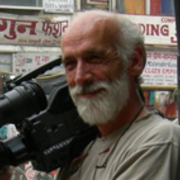
Mike Hardcastle
After Mike Hardcastle passed away in August 2016, many of his colleagues paid tribute on Facebook. They described him as supportive, warm-hearted, "a beautiful soul" — and "a filmmaker through and true".
Hardcastle was one of many who learnt the ropes in the 1970s, at legendary Wellington company Pacific Films. Actually he began earlier than that, after winning over Auckland producer Harry Reynolds by showing him some of his 8mm films. In 1971 Hardcastle joined Reynolds Television, where he spent time learning to cut film, and as a camera assistant. The following year he left the company, keen to join Pacific Films as an assistant editor.
But Pacific boss John O'Shea had all the editors he needed. So he took Hardcastle on as an assistant cameraman, changing the course of his career. Hardcastle was one of the large crew capturing the speeding vehicles on 1973 documentary Rally, and assistant cameraman on much of ground-breaking Māori series Tangata Whenua.
After a year at Pacific, he set off on his OE, where he ended up working for veteran British negative cutter Mike Fraser. At the time he was unaware that the laborious process of trying to get union membership in England could have been shortened by a couple of years, if only he had given the union boss a crate of champagne.
The following year, while living in Holland, Hardcastle was one of the troupe of expat Kiwis who rushed to France on a wing and a prayer, to shoot Lost in the Garden of the World, a documentary about the Cannes Film Festival. Capturing interviews with an emerging generation of new filmmakers (Spielberg, Scorsese, etc) helped inspire those present that New Zealand might even be able to join in. And so it was. Idiosyncratic German talent Werner Herzog stared into the lens, and told Hardcastle in no uncertain terms that putting the camera on a tripod would not be a good idea.
Arriving home in 1975, Hardcastle was just in time to join the explosion of Kiwi feature film production. After another year at Pacific, he was focus puller [whose exacting task is ensuring the right part of the image always stays in focus] and clapper loader on Solo, the first feature directed by another ex Pacific Films talent, Tony Williams. Despite faulty equipment which ultimately necessitated reshooting the movie — twice — Hardcastle and director of photography John Blick soldiered on, as Williams details here. Hardcastle would go on to provide a much needed shot of calmness when dealing with the mud, horses and other challenges on Pictures and Wild Horses.
Thanks to a string of iconic early feature films, including Middle Age Spread, Hardcastle soon gained a reputation as one of the best focus pullers in the country. Lacking any particular desire to take on the head job in the camera department — director of photography (aka cinematographer) — he found himself increasingly in demand for his skills as the person who operated the camera. Director of photography Rory O'Shea first asked him to camera operate on beautifully-lensed period piece Pictures (1981). Hardcastle also worked closely with soon-to-be-famous international visitors: operating the camera for cinematographer Chris Menges (soon to win an Oscar for The Killing Fields) on Battletruck, and focus pulling for director Mike Newell (Four Weddings and a Funeral) on classic man alone tale Bad Blood.
When a clampdown on tax breaks led to a dramatic cutback in local movie production, Hardcastle took a break from film, and became an oyster farmer. He returned to the industry in the early 90s as director and cameraman of When a Warrior Dies, produced by Warrick Attewell, another cameraman who had history at Pacific Films. The documentary examined the sinking of the Rainbow Warrior, but focused more on the the creation of a sculpture marking the boat's final resting place. The result was a finalist at New York's International Film and TV Festival.
The success of When a Warrior Dies led to more work as a cameraman, including 1993's Kupe - Voyaging by the Stars, which saw Hardcastle retracing Kupe's course across the Pacific, via waka. He also worked on Ngā Puna, a series of one-off Māori dramas led by Don Selwyn, a collaboration between newcomers and industry veterans. One of the episodes he shot was award-winning love story Kahu and Maia, starring Cliff Curtis. Hardcastle was also honing his skills as a director, writer and editor, in the process winning an ITVA Editing Award for a 2000 Courierpost corporate video.
In 2006 he was cameraman and editor on Out of Darkness, Out of India, a tale of ethnic dislocation directed by Owen Hughes for the Artsville series. He also edited The Chosen Ones — a series of eight 50-minute documentaries for Sky Sport — and worked on TV commercials and corporate videos as director, cameraman and editor.
Mike Hardcastle passed away in Auckland, early on the morning of 24 August 2016.
Profile written by Costa Botes; updated in August 2016
Sources include
Mike Hardcastle